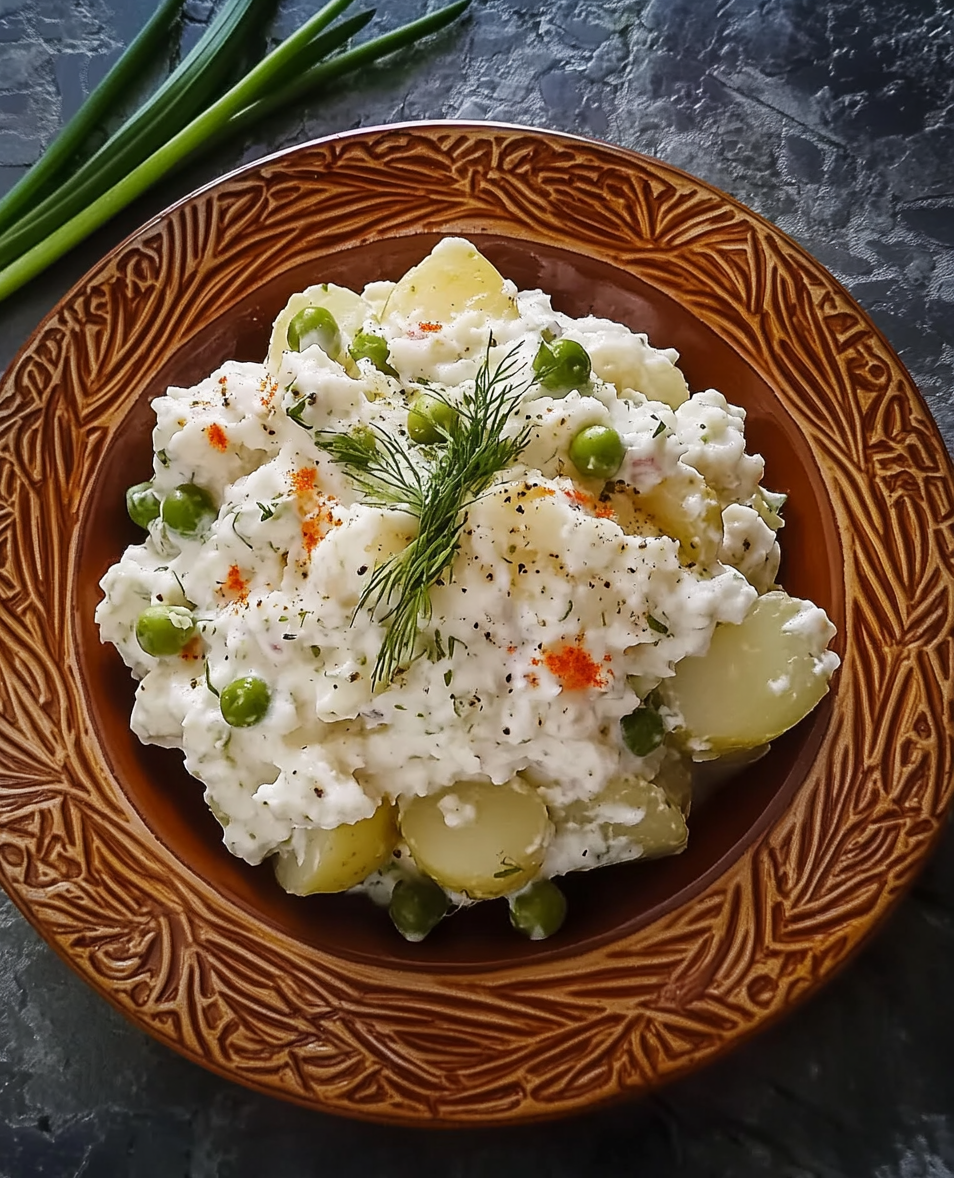Russian Potato Salad, also known as Olivier Salad, is a beloved dish across many households, especially during festive occasions. This salad combines tender boiled potatoes, carrots, eggs, peas, pickles, and either ham or chicken, all brought together with a generous amount of mayonnaise. It’s a creamy and flavorful side dish that pairs perfectly with a variety of main courses.
Ideal for gatherings, this salad is a crowd-pleaser, thanks to its hearty ingredients and comforting flavors. Whether served as a side at a holiday dinner or as a standalone dish at a potluck, Russian Potato Salad always delivers a satisfying and delicious bite. With simple ingredients and easy preparation, it’s a recipe that can be made in large batches to feed a hungry crowd.
Full Recipe:
- 5 potatoes
- 4 eggs
- 1 cup cooked chicken or ham, diced
- 1 cup pickles, diced
- 1 cup peas (canned or frozen)
- 1/2 cup carrots, diced
- 1/2 cup mayonnaise
- Salt and pepper to taste
Directions:
- Boil potatoes and carrots until tender. Let cool, then peel and dice.
- Hard boil the eggs, peel, and chop them.
- In a large bowl, combine diced potatoes, carrots, eggs, chicken (or ham), pickles, and peas.
- Add mayonnaise and mix well until everything is evenly coated.
- Season with salt and pepper to taste.
- Chill in the refrigerator for at least 30 minutes before serving.
Prep Time: 15 minutes | Cooking Time: 30 minutes | Total Time: 45 minutes
Kcal: 310 kcal | Servings: 6 servings
Russian Potato Salad, known as “Olivier Salad,” is a traditional dish that has become a staple in many Eastern European households, particularly in Russia. This hearty and creamy salad is often enjoyed during festive occasions such as New Year’s Eve, family gatherings, and holiday celebrations. The dish traces its roots back to the 1860s, when it was first created by Belgian chef Lucien Olivier, who worked in Moscow’s renowned Hermitage restaurant.
The original recipe, a closely guarded secret, was a luxurious creation made with high-end ingredients like grouse, caviar, and crayfish. Over time, the recipe evolved to reflect more accessible and everyday ingredients like potatoes, carrots, eggs, peas, pickles, and ham or chicken, all bound together by mayonnaise. This transformation made the dish a symbol of Russian culinary comfort, appealing to families across various social backgrounds.
Why is it Popular?
The popularity of Olivier Salad can be attributed to several factors:
- Simplicity: The recipe uses common ingredients that are easy to find and prepare.
- Versatility: You can modify the salad to suit your taste by adding or swapping ingredients, such as using different proteins (like ham, chicken, or even tofu for a vegetarian version).
- Convenience: It’s a great dish to prepare in advance, as the flavors meld even better after a few hours in the fridge. It’s ideal for large gatherings, potlucks, and parties.
- Nutrient-Rich: With vegetables, protein, and carbs, this salad is surprisingly filling and nutritious, making it a great choice for side dishes or even as a light main course.
Variations of Olivier Salad
Over the years, Olivier Salad has seen numerous variations across different countries:
- In Russia, the salad typically contains boiled potatoes, carrots, pickles, peas, and either chicken or ham.
- In Poland, it’s known as “Sałatka jarzynowa,” and might include apples for a slight sweetness and fresh dill for a herbal twist.
- In Ukraine, variations often include beets, adding a vibrant color and earthy flavor.
- In Spain, a version called “Ensaladilla Rusa” is served, often featuring seafood like tuna or shrimp.
Tips for the Perfect Olivier Salad:
- Use Homemade Mayonnaise: For a richer and more authentic taste, try making your own mayonnaise. It adds an extra level of creaminess and flavor to the dish.
- Chill Before Serving: Allow the salad to chill in the fridge for at least 30 minutes. This helps the flavors to meld and enhances the overall taste.
- Customization: Feel free to experiment by adding different ingredients like boiled eggs, cucumbers, or even a dash of mustard for a little kick.
- Presentation Matters: For a beautiful presentation, consider serving Olivier Salad in a large bowl with decorative garnishes like fresh herbs or extra sliced pickles.
The History Behind Olivier Salad
The salad was invented in the 1860s by Lucien Olivier, a French chef working at the Hermitage, one of Moscow’s finest restaurants. His original version was quite extravagant, featuring rare and expensive ingredients such as grouse, capers, crayfish tails, and smoked duck, all elegantly presented with a luxurious dressing. As times changed, the dish was simplified, and the ingredients adapted to what was readily available, thus becoming more accessible to the masses. Today, Olivier Salad, as we know it, is a simple yet satisfying dish made with boiled potatoes, carrots, eggs, peas, pickles, and either ham or chicken, all mixed in a creamy mayonnaise dressing.
The Role of Olivier Salad in Russian Culture
Olivier Salad has become synonymous with celebration in Russia and many Eastern European countries. It’s almost unthinkable to have a New Year’s Eve dinner without it. In fact, it’s often prepared in large quantities because it’s a dish that can be enjoyed over several days as leftovers. The salad’s adaptability to different tastes and preferences is one reason why it has remained a favorite across generations.
In Russia, Olivier Salad is often served as part of a zakuski table—an elaborate spread of appetizers similar to a buffet, designed for social gatherings. Along with other iconic dishes like herring under a fur coat (Shuba) and various types of smoked fish, Olivier Salad stands out as a must-have item.
Key Ingredients and Their Importance
- Potatoes: The foundation of the salad, providing a hearty base that absorbs the flavors of the dressing and other ingredients.
- Carrots: Adds a subtle sweetness and vibrant color, which contrasts well with the other ingredients.
- Pickles: These provide a crunchy texture and a tart, tangy flavor that balances out the richness of the mayonnaise.
- Eggs: Adds protein and creaminess, enhancing the texture of the salad.
- Chicken or Ham: The choice between chicken or ham often depends on personal preference, but both add a savory element that complements the vegetables.
- Peas: Green peas add a pop of color and a touch of sweetness, making them a quintessential part of this salad.
- Mayonnaise: The binding ingredient that brings the whole dish together, giving it that signature creamy consistency.
Nutritional Benefits
Despite being considered a comfort food, Olivier Salad offers a good balance of nutrients:
- Potatoes provide complex carbohydrates and fiber.
- Vegetables like carrots and peas contribute vitamins (such as Vitamin A and C) and minerals.
- Protein comes from the eggs and either ham or chicken, making it a complete meal when enjoyed as a main course.
- Mayonnaise, while calorie-dense, is rich in fats that can be substituted with a lighter version or homemade alternatives to suit dietary preferences.
Global Adaptations and Influence
Over the years, Olivier Salad has traveled beyond Russian borders and taken on new forms in various countries:
- In France, it’s sometimes prepared with additional herbs like tarragon or chervil, giving it a more aromatic profile.
- In Greece, Olivier Salad may include olives, adding a Mediterranean twist to the classic recipe.
- In Latin American countries, especially in Argentina and Peru, Olivier Salad is popular during Christmas and New Year’s celebrations, often including ingredients like apples or roasted red peppers.
- In Japan, it’s called “Russian salad” (ロシアンサラダ) and often features ingredients like boiled shrimp or squid, giving it a seafood dimension.
How to Customize Olivier Salad
One of the reasons Olivier Salad has remained popular for so long is its versatility. While the traditional recipe is beloved, there are countless ways to customize it to suit individual tastes or dietary requirements. Here are a few ideas:
- Vegetarian Version: Omit the meat and use tofu or chickpeas for added protein. You can also add more vegetables like cucumbers or red onions for extra crunch.
- Low-Calorie Option: Use a light or homemade mayonnaise to reduce the calorie content, or substitute with Greek yogurt for a tangier and healthier version.
- Vegan Version: Replace the eggs and meat with vegan alternatives such as marinated tofu or tempeh, and use vegan mayonnaise.
- Gluten-Free: This salad is naturally gluten-free, making it a safe choice for those with celiac disease or gluten sensitivities.
Serving Suggestions
Olivier Salad is typically served chilled, making it a great side dish for warm-weather gatherings, but it’s also a comforting addition to winter holiday tables. It pairs well with a variety of main dishes, including grilled meats, fish, or roasted vegetables. To add a gourmet touch, you can serve it with a garnish of fresh dill, parsley, or chives.
It can also be served in creative ways:
- In Lettuce Cups: Spoon the salad into large butter lettuce leaves for a light and elegant presentation.
- As a Sandwich Filling: Spread Olivier Salad between two slices of crusty bread or in a pita for a hearty lunch option.
- In Pastry Shells: Serve small portions in puff pastry shells or on top of crackers as a sophisticated appetizer.
Conclusion
Olivier Salad, or Russian Potato Salad, is a timeless and versatile dish that blends hearty ingredients like potatoes, eggs, vegetables, and meat with creamy mayonnaise. Its rich history, cultural significance, and ease of customization make it a perfect addition to any meal, whether for a festive gathering or a simple family dinner. With its global appeal and countless variations, Olivier Salad remains a beloved classic that continues to bring comfort and flavor to tables worldwide.






